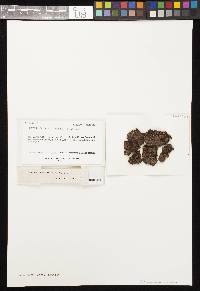
Consortium of Lichen Herbaria
- building a Global Consortium of Bryophytes and Lichens as keystones of cryptobiotic communities -
- Home
- Search
- Images
- Species Checklists
- US States: O-Z >
- US National Parks
- Central America
- South America
- US National Parks
- Southern Subpolar Region
|
|
|
|
Family: Verrucariaceae
[Catapyrenium chilense (Rasanen) Breuss] |
Nash, T.H., Ryan, B.D., Gries, C., Bungartz, F., (eds.) 2002. Lichen Flora of the Greater Sonoran Desert Region. Vol 1. Thallus: squamulose or almost foliose squamules: up to more than 10 mm wide and 0.6 mm thick, loosely adnate with margins free from the substrate or ± wavy and overlapping to imbricate surface: light to medium brown, dull to slightly glossy upper cortex: 30-60 µm thick, overlain by an epinecral layer (5-25 µm thick) medulla: white, prosoplectenchymatous, up to 300 µm thick, normally with (very) few spherical cells; algal layer: c. 80-150 µm high lower cortex: well delimited and 40-90 µm thick, composed of roundish-angular cells (12-20 µm in diam.) lower surface: pale along a broad marginal zone, blackening towards the center, rarely dark throughout; marginal zone: bare of rhizohyphae and often slightly scabrous or with short hyphal outgrowths; rhizohyphae: hyaline, c. 5-6 µm thick, forming a dense hyphal weft in central parts of the squamules Perithecia: up to 0.5 mm broad, with pale walls; periphyses: 25-35 x 3 µm asci: cylindrical, 60-70 x 7-10 µm, 8-spored ascospores: uniseriate, ellipsoid, c. 10-15 x 5-6 (-6.5) µm Pycnidia: laminal, immersed conidia: oblong to shortly cylindrical, 3-4 x 1-1.5 µm Spot tests: all negative Secondary metabolites: none detected. Substrate and ecology: soil, debris and mossy rocks, rarely directly on rock (sandstone, rhyolite, andesite, limestone) mostly in somewhat protected situations in open woodland or scrubland World distribution: South America and southern North America Sonoran distribution: common in Arizona, California, Baja California and Baja California Sur, Sonora and Chihuahua. Notes: Placidium chilense is an easily discernible species due to its comparatively large, almost leafy, thick squamules with a prosoplectenchymatous medulla, small spores and laminal pycnidia. Specimens with unusually numerous spherical medullary cells may be confused with P. squamulosum, but the cells of the lower cortex are smaller in the latter species. Placidium rufescens is similar in appearence, but easily distinguished by marginal pycnidia and large spores. Large forms of P. lacinulatum may be similar, but differ clearly in the anatomy of medulla and in having rhizines. |
Powered by Symbiota


















